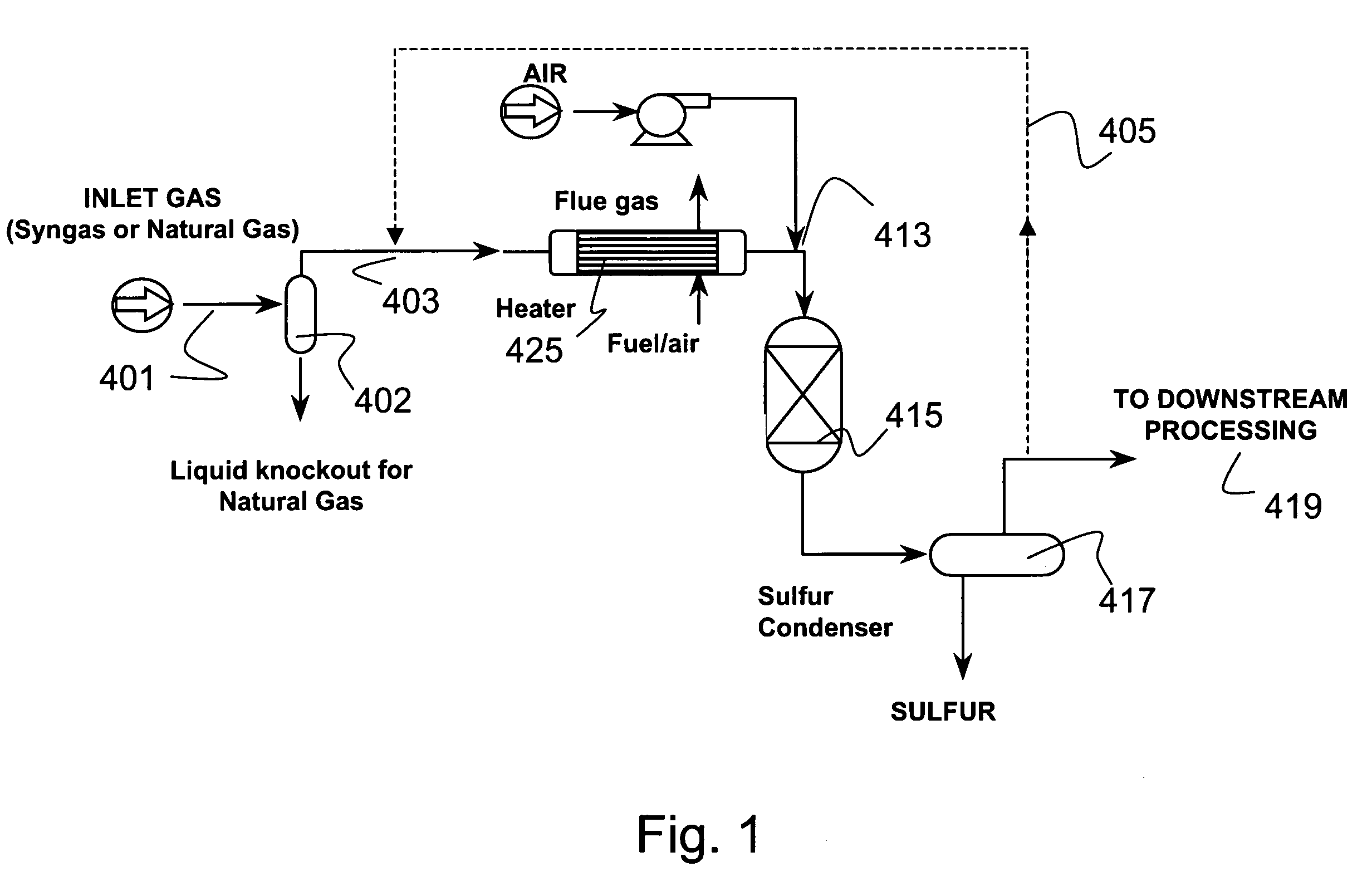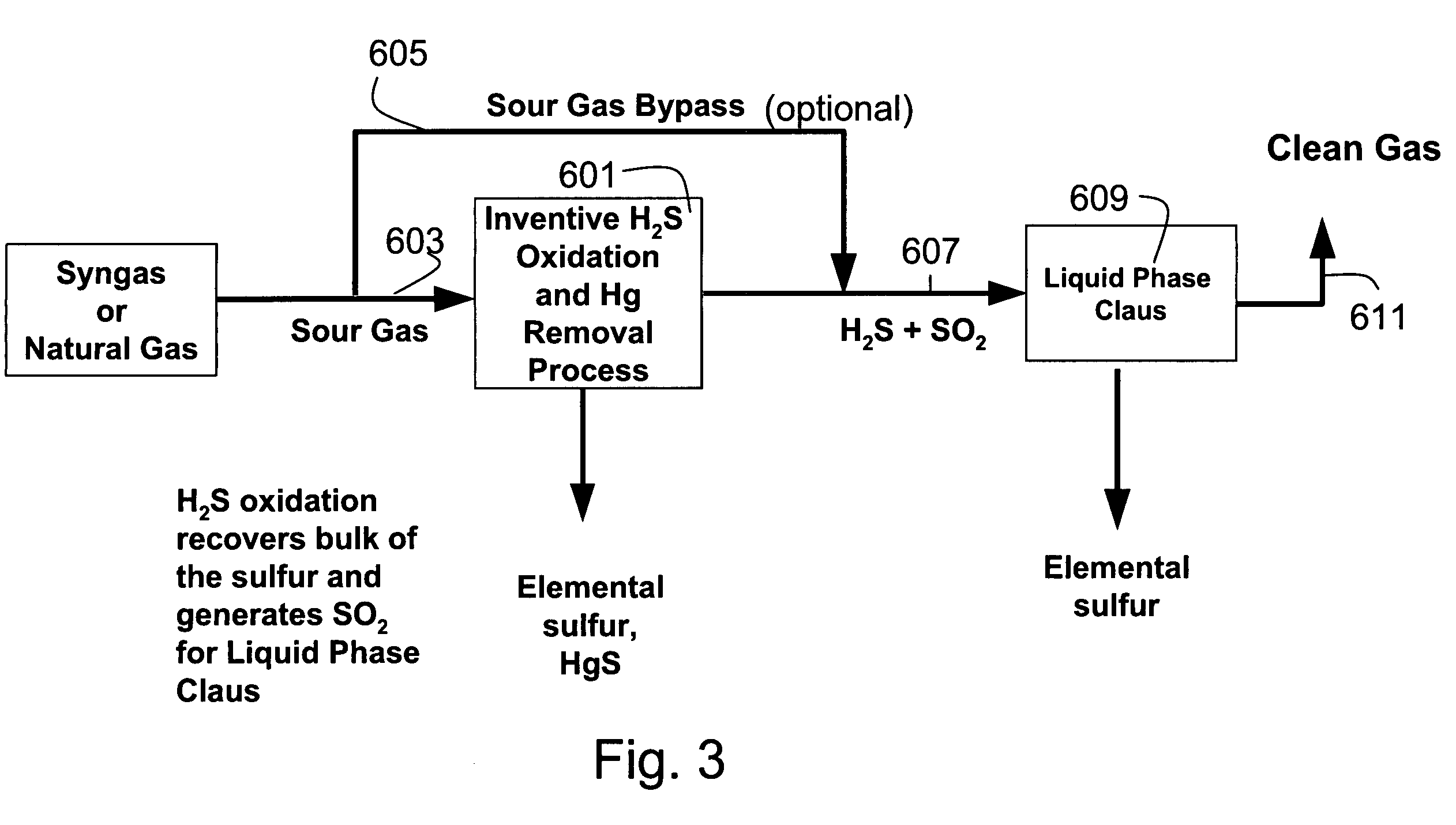Process for the simultaneous removal of sulfur and mercury
a technology of simultaneous removal and sulfur, applied in the direction of separation processes, sulfur preparation/purification, hydrogen sulfides, etc., to achieve the effect of reducing the size of the unit, simplifying the process, and reducing the capital and operating costs of the plan
- Summary
- Abstract
- Description
- Claims
- Application Information
AI Technical Summary
Benefits of technology
Problems solved by technology
Method used
Image
Examples
example 1
Equilibrium Calculations
[0127]A typical composition of syngas is shown in Table 3. For high sulfur coal, the H2S concentration was assumed to be 10,000 ppm. For low sulfur coal, the H2S concentration was assume to be 100 ppm This composition was assumed for all the equilibrium and economic analyses in this section. The pressure was assumed to be 30 atmospheres. The syngas enters the direct oxidation and mercury removal reactor. The hydrogen sulfide is oxidized to sulfur and water (>90% conversion of H2S to S). The molar composition of the gas stream at the direct oxidation reactor outlet is shown in Table 4. The sulfur that is formed in the reactor is then cooled to between 120–140° C. in a sulfur condenser, where the sulfur vapors are condensed into molten sulfur. The molten sulfur drains out of the sulfur condenser and is collected for disposal.
[0128]FIG. 8 and FIG. 9 show the mercury removal efficiency and the resultant mercury concentration at the sulfur condenser outlet for bot...
example 2
Economics
[0130]An economic analysis of the Hg removal in the gasified stream has been undertaken. For high sulfur coal, 10,000 ppm H2S was used as the basis concentration in the gas. For low sulfur coal, 800 ppm was used H2S in the gas. For the high sulfur coal, assuming that all the sulfur is land filled (at an expense of $25 / ton) and adding an opportunity cost of $35 / ton (for not being able to use the sulfur), we arrive at a cost of $4795 / lb of mercury disposed. For the low sulfur coal, with the same assumptions, we arrive at a cost of $384 / lb of mercury.
[0131]In the second case, we assumed that, instead of land filling the sulfur, we will be distilling the sulfur so that, the mercury and sulfur are separated. Using this method, we have assumed that 90% of the sulfur will be free of Hg and will be available for sale. The remaining 10% of the sulfur which will be combined with the mercury will need to be land filled. In addition, we have calculated a capital cost of $20 / ton sulfur ...
example 3
[0132]To avoid bed fouling or equipment plugging, it is preferred to operate a catalytic reactor of this invention in a pressure and temperature regime where any elemental sulfur formed in the reaction will remain in the vapor phase. The experiments reported show that for the best catalysts, the preferred operating temperature was 250° C. The dew point pressure for elemental sulfur at 250° C. determines the maximum concentration of sulfur vapor that can be present over the catalyst. This is linked to the maximum allowable H2S concentration via the selectivities to SO2 and sulfur. Higher selectivities to SO2 permit the processing gases with higher H2S concentrations.
[0133]An example of how the maximum allowable H2S concentration is calculated is discussed below. Sulfur vapor-liquid-equilibrium (VLE) calculations can be readily performed for different temperatures and concentrations of sulfur vapor. At T=250° C. for 2000 ppm of elemental sulfur vapor condensation start...
PUM
| Property | Measurement | Unit |
|---|---|---|
| Temperature | aaaaa | aaaaa |
| Temperature | aaaaa | aaaaa |
| Temperature | aaaaa | aaaaa |
Abstract
Description
Claims
Application Information
 Login to View More
Login to View More - R&D
- Intellectual Property
- Life Sciences
- Materials
- Tech Scout
- Unparalleled Data Quality
- Higher Quality Content
- 60% Fewer Hallucinations
Browse by: Latest US Patents, China's latest patents, Technical Efficacy Thesaurus, Application Domain, Technology Topic, Popular Technical Reports.
© 2025 PatSnap. All rights reserved.Legal|Privacy policy|Modern Slavery Act Transparency Statement|Sitemap|About US| Contact US: help@patsnap.com



